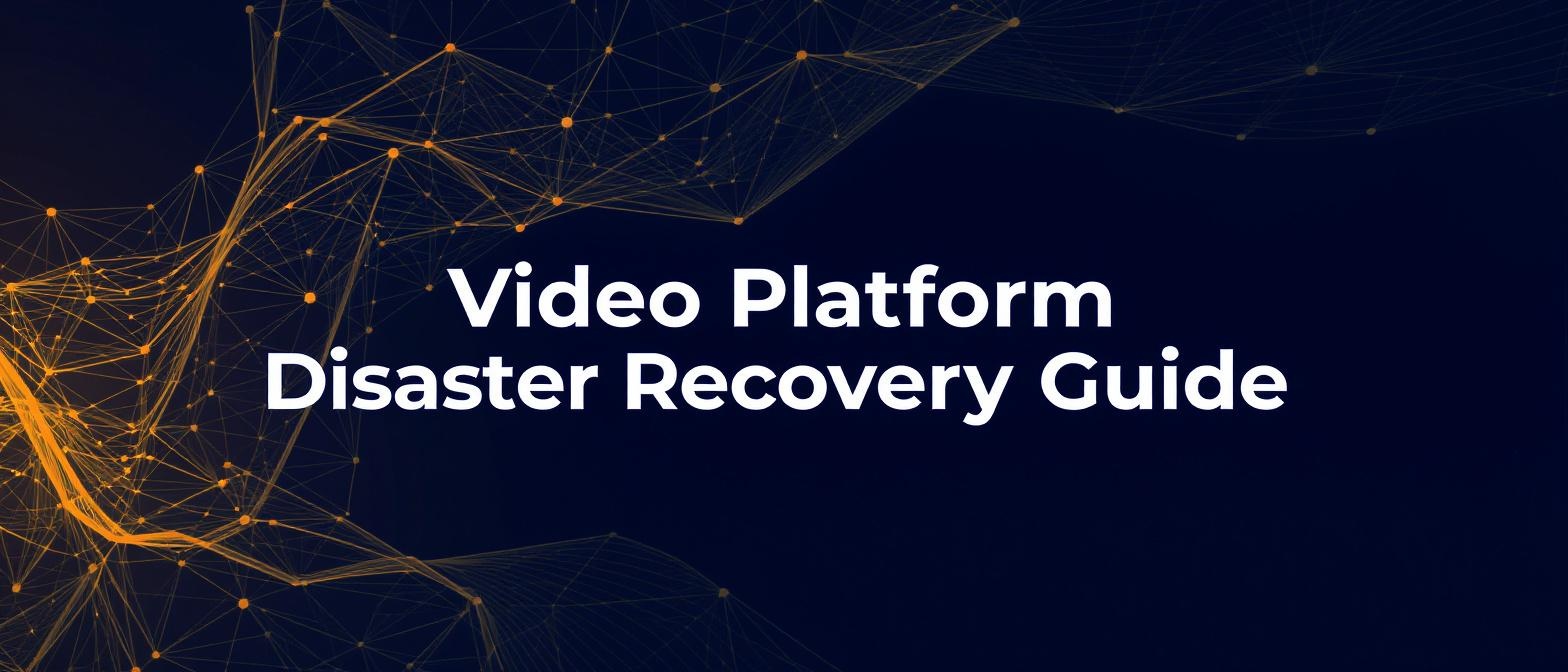Ensuring Business Continuity with Video Platform Disaster Recovery: A Comprehensive Guide
Estimated Reading Time: ~12 minutes
Key Takeaways
- A robust disaster recovery plan is essential to protect revenue and reputation.
- Defining RPO and RTO helps minimize data loss and downtime.
- Active-active redundancy and automated failover enable near-zero interruption.
- Solutions like TrueFan AI integrate hyper-personalization with resilient infrastructure.
- AI-driven monitoring will shape future enterprise video resilience.
In today's digital-first economy, video is not just content; it is a critical business asset for customer engagement, communication, and revenue generation. The global enterprise video platform market is projected to reach $25.11 billion in 2025, underscoring its central role in modern business strategy. But what happens when the infrastructure powering this vital asset fails? This is where video platform disaster recovery becomes one of the most crucial, yet often overlooked, components of a resilient enterprise.
Unplanned video-service outages can be catastrophic, leading to immediate revenue loss, irreversible reputation damage, and significant regulatory risk. A 2025 report highlights that cybercrime-related downtime alone is expected to cost businesses $10.5 trillion annually, with some outages costing upwards of $53,000 per hour. For businesses that rely on real-time, personalized video delivery, the challenges are even greater, involving massive data volumes, the need for low-latency delivery, and maintaining continuity for a global audience. Effective business continuity video systems are no longer a luxury—they are a necessity for survival and growth.
This guide provides a comprehensive framework for building a robust video platform disaster recovery plan. We will explore everything from foundational backup strategies to advanced failover mechanisms and the future of AI-driven resilience, ensuring your video operations remain seamless, no matter the disruption.
1. What Is Video Platform Disaster Recovery?
At its core, video platform disaster recovery is a specialized set of strategies, technologies, and procedures designed to protect and restore an organization's video infrastructure. This includes its servers, content libraries, metadata, user interaction data, and personalization engines following a disruptive event. The primary goal is to ensure data availability and uninterrupted service, safeguarding the business's operational integrity.
It is important to distinguish disaster recovery (DR) from business continuity. Disaster recovery planning for video focuses specifically on the IT aspect—restoring the technological systems and data required to deliver video content. In contrast, business continuity video systems represent a broader strategy to maintain all essential video-related business functions during an incident, ensuring the organization can continue to operate and serve its customers with minimal disruption.
Common disruptions that necessitate a DR plan include:
- Data Center Outages: Physical failures at a primary data center due to power loss, cooling system failure, or hardware malfunctions.
- Network Failures: Widespread internet or CDN (Content Delivery Network) outages that prevent users from accessing video content.
- Cyberattacks: Ransomware, DDoS attacks, or data breaches that compromise video assets or delivery infrastructure.
- Natural Disasters: Events like floods, earthquakes, or hurricanes that can physically destroy infrastructure.
Source: cloud.google.com/learn/what-is-disaster-recovery
Source: massive.io/content-security/cloud-disaster-recovery-in-video-production/
2. Enterprise Video Backup Strategy
An effective enterprise video backup strategy is the foundation of any disaster recovery plan. Its strategic purpose is to minimize two critical metrics: Recovery Point Objective (RPO), the maximum acceptable amount of data loss, and Recovery Time Objective (RTO), the maximum acceptable downtime. For enterprises managing terabytes or even petabytes of video content, a robust backup strategy is non-negotiable.
Core Backup Methodologies
Modern video platforms leverage a multi-layered approach to backups to ensure comprehensive protection. Learn More.
- Cloud-Native Backups: Utilizing services from major cloud providers like AWS, GCP, and Azure is standard practice. This includes creating automated, versioned backups of video files in object storage (like S3 or GCS) and taking point-in-time snapshots of databases and virtual machines that store metadata and user information.
- Disaster Recovery as a Service (DRaaS): DRaaS solutions offer an advanced layer of automation. These services continuously replicate entire virtual machines (VMs) or containerized environments to a secondary location, enabling highly automated and orchestrated restoration in the event of a failure.
- Geo-Replication: This involves automatically replicating video data across multiple geographic regions. If one region goes offline due to a large-scale outage, traffic can be rerouted to another region where the data is already available, ensuring video content redundancy.
The 3-2-1 Rule: A Timeless Principle
A cornerstone of data protection is the 3-2-1 rule. This simple yet powerful principle dictates that you should:
- Keep three copies of your video data.
- Store these copies on two different types of media.
- Keep one of these copies offsite.
For a modern video platform, this could mean having the primary data on a cloud server, a second copy on a different cloud provider or in a separate region, and an offline or air-gapped backup for ultimate protection against cyberattacks.
Strategic Retention Policies
Finally, a backup strategy must be governed by clear retention policies. These policies define how long different types of video content are stored, based on business needs and regulatory compliance. For example, user-generated content may have different retention requirements than licensed media assets, and data must be kept in a manner that adheres to standards like GDPR or CCPA. Learn More.
Source: allcloud.in/blog/fueling-finance-how-cloud-technology-is-changing-commercial-vehicle-loans
3. Video Content Redundancy and Business Continuity
While backups are essential for recovery after an event, video content redundancy is what enables true business continuity during an event. Redundancy involves maintaining duplicate, synchronized copies of video assets, metadata, and personalization files in geographically separate locations. This architecture is the key to achieving near-zero data loss and instantaneous user failover.
The most effective redundancy architectures use an active-active or hot/warm site model. In an active-active setup, two or more data centers are live and serving user traffic simultaneously. If one fails, the other clusters instantly absorb the load without any service interruption. This architecture provides the highest level of availability for business continuity video systems. Learn More.
The primary benefits of a redundant architecture are profound:
- Zero-Data-Loss Restores: Because data is replicated in real-time, failover to a secondary site occurs with no loss of content or user data.
- Near-Instant User Failover: Traffic is automatically rerouted at the DNS or CDN level, meaning users experience seamless playback continuity, often without even realizing a failover has occurred.
- Enhanced Performance: During normal operations, geo-redundancy can improve user experience by serving content from the data center closest to the user, reducing latency.
In the Indian market, companies have increasingly adopted hybrid cloud deployments to enhance business continuity. For instance, Nutanix has enabled media workflows to leverage a mix of on-premises and public cloud infrastructure to ensure their DR and business continuity plans are robust and flexible, reflecting a broader industry trend toward resilient, multi-cloud architectures.
Source: itupdate.in/redirect?publication=27156
Source: cloud.google.com/learn/what-is-disaster-recovery
4. Video Platform Failover Mechanisms
A video platform failover is the process of switching from a primary system to a backup system when a disruption occurs. The speed and success of this process are determined by the type of failover mechanism and the level of automation involved. Orchestration is key to a successful video platform disaster recovery event.
Types of Failover Sites
- Hot Failover: This involves a fully operational, active backup cluster that receives real-time data replication from the primary site. In case of a failure, the switchover is automatic and nearly instantaneous, offering the lowest RTO.
- Warm Failover: A warm site has the necessary hardware and network connectivity but may require some manual intervention to bring services online. Data is synchronized periodically (e.g., every few hours), resulting in a slightly longer recovery time but at a lower cost.
- Cold Failover: A cold site is the most basic option, with infrastructure in place but requiring manual setup and data restoration from backups. This approach has the longest RTO and is suitable only for non-critical services.
Orchestration and Automation
Modern failover is not a manual process. It is orchestrated using a suite of automated tools. DNS-level routing, managed by services like Amazon Route 53 or Cloudflare, can automatically redirect user traffic to a healthy data center. CDNs can also shift traffic based on origin server health. For containerized video services running on Kubernetes, operators can be programmed to automatically spin up new instances in a different cluster or region if the primary one becomes unresponsive.
For hyper-personalized content, this orchestration becomes even more critical. Platforms like TrueFan AI enable real-time personalization APIs that can trigger new video renders from a backup GPU farm in under 30 seconds. This capability ensures that even during a failover event, the platform can continue to deliver unique, personalized experiences, preserving crucial elements like lip-sync and voice clone continuity. This was demonstrated during Zomato's Mother's Day campaign, where a massive surge to 354,000 unique video deliveries stress-tested and proved the system's automated failover capabilities without any service interruption.
Ensure that your DR plans align with video platform security standards. Learn More.
5. Disaster Recovery Planning for Video Systems
A robust disaster recovery planning video strategy relies on more than just technology; it requires a meticulously documented and regularly tested plan. Pre-defined playbooks are essential to reduce human error during a high-stress incident and ensure that Recovery Time Objectives (RTO) and Recovery Point Objectives (RPO) are consistently met. A shocking 2025 report from Cockroach Labs revealed that just 20% of executives feel their organizations are fully prepared for an outage, highlighting a critical gap in strategic planning.
Key Components of a DR Plan
An effective DR plan for video systems should include several core components:
- Risk Assessment and Business Impact Analysis (BIA): Identify potential threats to your video services and analyze the business impact of an outage (e.g., lost revenue, customer churn, brand damage).
- Defined RTO and RPO: Formally establish your targets. For a critical live streaming service, your RTO might be near-zero, while for an internal training video library, an RTO of several hours might be acceptable.
- Backup and Replication Schedule: Create a detailed matrix outlining backup frequency (e.g., hourly database snapshots, daily full backups of video assets) and replication intervals.
- Metadata and Personalization Data Preservation: Your plan must explicitly cover how to protect and restore critical metadata (titles, tags, descriptions) and user personalization data, which are often stored in separate databases.
- Failover Orchestration Runbooks: Develop step-by-step scripts and documented procedures (runbooks) for executing the failover process, whether automated or manual.
- Regular Testing and Drills: A plan that is not tested is just a document. Conduct regular DR drills—from tabletop exercises to full failover simulations—to validate the plan and train the team. Post-mortems after each drill are crucial for refinement.
A Step-by-Step Implementation Template
- Assemble the DR Team: Assign clear roles and responsibilities (e.g., DR Coordinator, Communications Lead, Technical Recovery Teams).
- Conduct the BIA: Prioritize video services based on their criticality to the business.
- Select DR Strategies: Choose the appropriate backup and failover mechanisms (hot, warm, cold) for each service based on its RTO/RPO.
- Document the Plan: Create the runbooks, communication trees, and failover triggers.
- Test and Refine: Schedule quarterly DR tests and update the plan based on findings.
Source: cloud.google.com/learn/what-is-disaster-recovery
Source: everbridge.com/products/bc-in-the-cloud-everbridge
Source: cockroachlabs.com/blog/the-state-of-resilience-2025
6. Case Studies: Resilience in Action
The true test of a video platform disaster recovery strategy is its performance under pressure. Real-world examples demonstrate how robust planning and advanced video platform failover mechanisms translate into uninterrupted service and enhanced customer engagement.
- Zomato Mother’s Day Campaign: In a massive one-day event, TrueFan’s platform delivered 354,000 unique, personalized celebrity videos. The unprecedented traffic surge acted as a real-world stress test, validating the platform’s ability to scale and failover seamlessly across its distributed infrastructure, ensuring 100% uptime during a critical revenue event.
- Goibibo Personalized Travel Nudges: Goibibo leveraged personalized videos to re-engage users, resulting in a 17% higher read rate on WhatsApp. The campaign's success depended on the platform's ability to trigger these videos in real-time, with redundancy ensuring that the user engagement funnel remained active despite any minor outages.
- Hero MotoCorp Festive Greetings: Generating 2.4 million multilingual personalized videos for a festive campaign required immense processing power distributed across multiple data centers. The platform’s geo-redundant architecture ensured uninterrupted generation even if one cluster faced performance degradation.
- Cipla Doctor’s Day Initiative: For Cipla, delivering 6,400 personalized thank-you messages to doctors required absolute reliability. The platform’s high-availability setup guaranteed every message was delivered successfully, reinforcing brand trust.
Solutions like TrueFan AI demonstrate ROI through these examples, proving that a resilient, scalable video platform not only prevents loss but actively drives engagement and business growth.
7. TrueFan’s Unique Offerings for Video Disaster Recovery
For enterprises where hyper-personalization is key, standard DR solutions fall short. TrueFan provides a suite of advanced, AI-driven capabilities designed to ensure not just uptime, but the continuity of highly personalized customer experiences, making their business continuity video systems exceptionally robust.
- Hyper-Personalization at Scale: TrueFan AI operates on a cloud-agnostic GPU farm, ensuring that video rendering is not dependent on a single cloud provider. This infrastructure is ISO 27001 and SOC 2 compliant, providing enterprise-grade security and reliability.
- Virtual Reshoots: During a disaster, access to talent or studios may be impossible. TrueFan’s AI allows for “virtual reshoots,” where existing video footage can be edited to deliver new messaging by altering speech and lip movements—critical for crisis communications.
- Multilingual Localization for Global Continuity: With TrueFan AI’s 175+ language support, businesses can maintain global communication continuity. Perfect lip-sync ensures messages are delivered with local relevance and authenticity.
- Real-Time API Integration: The platform’s APIs can be triggered in under 30 seconds from any enterprise system. If a primary system fails, a backup can immediately resume triggering personalized videos, preserving the customer experience without missing a beat. See More.
- Analytics and Optimization: A key part of disaster recovery planning video is learning. TrueFan’s platform includes analytics dashboards that track RTO/RPO compliance, providing data to refine recovery playbooks and enhance personalization performance even under stress.
8. The Future of Enterprise Video Resilience
The landscape of video platform disaster recovery is rapidly evolving, driven by advancements in AI and cloud orchestration. As video becomes more integrated into mission-critical operations, resilience strategies are becoming more proactive and intelligent.
Emerging Trends for 2025 and Beyond
- Predictive AI Monitoring: The next frontier is not just reacting to failures but predicting them. AI algorithms can monitor infrastructure for anomalies and trigger failovers before a catastrophic outage occurs.
- Cross-Cloud Orchestration: To avoid vendor lock-in and increase video content redundancy, enterprises are moving towards unified control planes that manage workloads across multiple clouds.
- Generative AI for Real-Time Content Adaptation: During a live event affected by a disaster, generative AI can instantly update video scripts and re-render content with new messaging.
- Edge Rendering for Localized Resilience: By moving video rendering to edge nodes, businesses create localized pockets of resilience; if a central data center goes down, edge nodes can still serve cached content.
TrueFan is at the forefront of these innovations, investing in R&D to integrate predictive analytics and generative AI into its platform, ensuring enterprise clients are prepared for future disruptions.
Source: mha-it.com/blog/top-business-continuity-trends-for-2025
Conclusion
In an era defined by digital engagement, the resilience of your video platform is synonymous with the resilience of your business. A strategic video platform disaster recovery plan is not an IT expense; it is a fundamental investment in protecting revenue, preserving customer trust, and ensuring brand continuity. From foundational backup strategies and multi-region video content redundancy to automated failover mechanisms and meticulous planning, every element works in concert to build a system that can withstand disruption.
As we have seen, the financial and reputational costs of downtime are staggering. By embracing a proactive approach that includes rigorous planning, regular testing, and leveraging advanced solutions, organizations can transform their video infrastructure from a potential point of failure into a durable competitive advantage. The future of video resilience is intelligent, automated, and personalized—and preparing for it today is the key to thriving tomorrow.
Frequently Asked Questions
1. What is the difference between RPO and RTO in video disaster recovery?
Recovery Point Objective (RPO) refers to the amount of data you can afford to lose, measured in time (e.g., 15 minutes of data). Recovery Time Objective (RTO) is the amount of time you can afford to be down before the service is restored (e.g., 5 minutes of downtime). For a live video stream, both RPO and RTO should be as close to zero as possible.
2. How often should we test our video platform DR plan?
Most experts recommend conducting tabletop exercises quarterly and full failover drills at least annually. For mission-critical video services, testing should be more frequent. The key is to test regularly enough that your team is prepared and your documentation remains current.
3. Can a CDN replace the need for a DR plan?
No. While a Content Delivery Network (CDN) is a critical component of a resilient video delivery architecture, it does not protect your backend infrastructure. If your origin servers, databases, or video processing pipelines go down, a CDN cannot restore them. It is part of the solution, not the entire solution.
4. How does personalization data get protected during a disaster?
Protecting personalization data (e.g., user names, locations, purchase history) is crucial. This data is typically stored in databases that must be part of the DR plan. Strategies include real-time database replication to a secondary site, point-in-time snapshots, and ensuring that your failover runbooks include steps to verify data integrity after a restore.
5. How can platforms like TrueFan AI improve DR for personalized video campaigns?
TrueFan AI enhances DR by operating on a cloud-agnostic, geo-redundant infrastructure that ensures rendering capabilities are always available. Its real-time APIs can seamlessly switch to backup systems to continue triggering personalized videos, while features like “Virtual Reshoots” allow for urgent messaging changes even when primary production facilities are inaccessible, ensuring both technical and creative continuity.
Take the Next Step
Is your video infrastructure prepared for the unexpected? Assess your readiness today.
- Download our Enterprise Video Disaster Recovery Checklist to evaluate your current strategy against industry best practices.
- Schedule a Free Consultation with our resilience experts to discuss how TrueFan’s AI-powered platform can help you build a world-class disaster recovery plan for your personalized video content.




